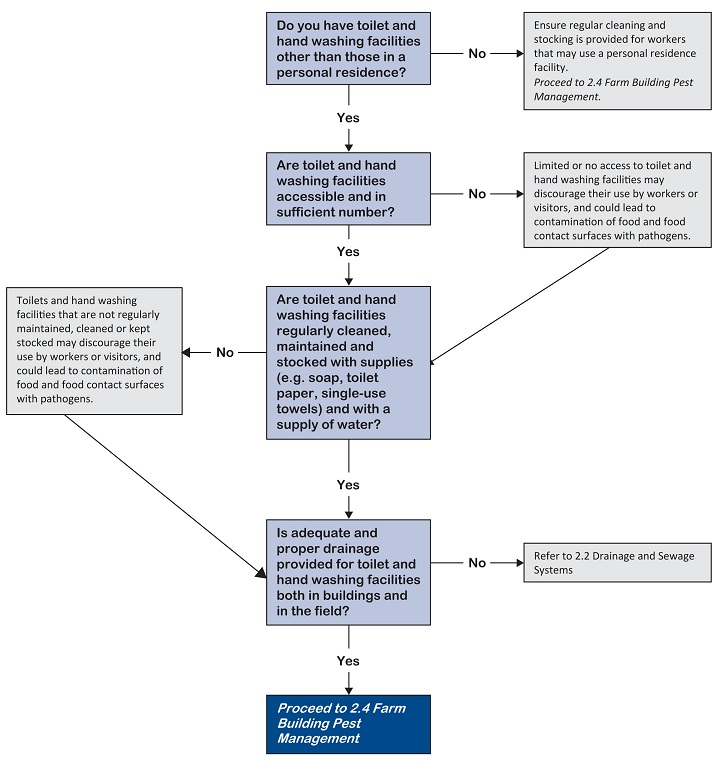Farm buildings and Access - 2.3 Toilet and hand washing facilities
If clean, well-stocked and properly functioning toilet and hand washing facilities are not available, workers, visitors and customers can cause contamination.

This good agricultural practice applies to farms where milk, eggs, honey, fruits, nuts or vegetables are produced. It does not include personal residence facilities.
What needs to be done
Make sure workers, visitors and customers have easy access to clean, well-stocked, properly functioning toilet and hand washing facilities.
How to do it
Number of toilet and hand washing facilities
When determining the number of toilets and hand washing facilities to have on site:
- Consider the number of workers and capacity of the toilet (for portable toilets)
- Consider a general rule of thumb of 1 toilet per 25 workers
- Consider using portable toilet and hand washing facilities if permanent facilities are not feasible or are not available
Location
Locate a sufficient number of toilet and hand washing facilities in areas where they can be easily accessed (within 400 metres of a work site or as the farm landscape allows), but where they do not pose a risk of food contamination (for example, away from a water source or near harvesting, handling, storage, packaging or shipping areas).
Maintenance:
- Make sure toilet and hand washing facilities are properly designed, constructed, maintained and ventilated, and kept clean. Learn more about cleaning and sanitizing and drainage and sewage systems
- Stock toilet and hand washing facilities with adequate supplies of soap, potable water, hand sanitizing lotions or wipes, toilet paper, and single use towels. Check facilities frequently to make sure they are well-stocked
- Provide durable and cleanable waste containers. Collect and dispose of trash regularly so it doesn’t become a contamination hazard
- When sanitation facilities are serviced, take precautions to ensure that waste does not drain into fields or run off into a water source
- Consider what to do in the event of a spill from a portable toilet to prevent cross-contamination of food or production areas
Records to keep
If you need an audit
Be prepared for the auditor to:
- Observe whether a sufficient number of toilets and hand washing facilities are available
- Observe whether portable toilet and hand washing facilities are easily accessed and do not pose a risk of contamination
- Observe whether toilet and hand washing facilities are adequately stocked and clean
- Review toilet and hand washing facilities cleaning records
Laws and regulations
There are few laws that impact on food safety requiring toilet facilities and hand washing areas in agricultural production. Generally, these requirements are laid out in laws regarding the processing of meat, fish and other food products, including egg-grading stations, which are outside the scope of this document.
- The Food Premises Regulation, Reg. 210/99, s. 5 under the Public Health Act specifies requirements for washroom facilities. However, s. 2 provides that premises selling only whole fruits or vegetables or pre-packaged, non-potentially hazardous food are exempt from the requirements. S. 21 (4) requires operators of food premises to supply and maintain handwashing stations that meet the following requirements: a hand basin provided with:
- Hot and cold running water
- Soap in a dispenser
- A method of hand drying that uses single service products
- The Occupational Health and Safety Regulation, Reg. 296/97, s. 4.85 under the Workers Compensation Act requires employers to supply washroom and hand wash facilities for workers. The facilities must be maintained in working order, kept clean and sanitary, and provided with the necessary supplies
| Go back to 2.2 Drainage and sewage systems | Proceed to 2.4 Farm building pest management |
